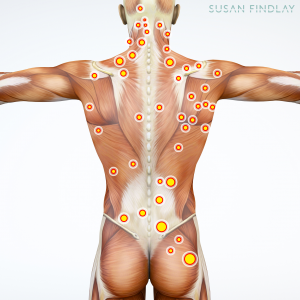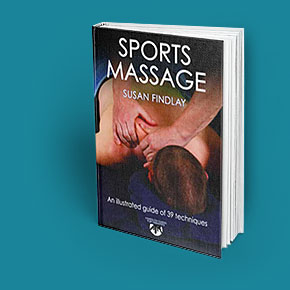The phrase “muscle knot” is widely used. Most people understand what it is to have one, but recently I’ve noticed some misinformation flying about, and thought I should pose the question as to whether these “knots” are being understood and consequently treated correctly? Could the feeling of tightness and pain we associate with muscle not in fact be caused by a multitude of reasons? This article will seek to explain what a muscle “knot” is within existing scientific frameworks, looking at popular and perhaps erroneous methods of treating them, while also outlining how I believe they should be treated.
A widely respected school of linguistic thought states that the way in which we understand language informs the way in which we understand the world. If we understand localised muscle pain as a “knot”, then could this affect the way they are treated? After all, undoing a particularly tightly tied knot can be an arduous process using nails, teeth, and extreme force.
Scientists refer t o muscle knots as ‘Myofascial Trigger Points’ (MTPs); these are loosely defined as an irritable spot in the muscle which is painful upon compression (2). They can also lead to a restricted range of motion (3). When they are examined with a thermal camera, it can be seen that they have an area of higher temperature surrounded by an area of lower temperature; this implies that there is a restricted blood flow in this part (4). They are also observable using ultrasound (5). They can also be seen via a microscope, but obviously to use this as a diagnostic measure would be incredibly invasive (6).
o muscle knots as ‘Myofascial Trigger Points’ (MTPs); these are loosely defined as an irritable spot in the muscle which is painful upon compression (2). They can also lead to a restricted range of motion (3). When they are examined with a thermal camera, it can be seen that they have an area of higher temperature surrounded by an area of lower temperature; this implies that there is a restricted blood flow in this part (4). They are also observable using ultrasound (5). They can also be seen via a microscope, but obviously to use this as a diagnostic measure would be incredibly invasive (6).
As John Sharkey, clinical anatomist, exercise physiologist, founder of European Neuromuscular Therapy (ENMT) and a recognised authority in the treatment of myofascial pain states in his three part course: Treating Myofascial Pain Using Biotensegrity Informed Touch points out – “X” does not mark the spot. It is said that MTPs can cause pain in different locations; at their location; at the origin of the muscle; and referred pain outside of the MTP. This is due to the physical tightness of the MTP pulling on the muscle. The implication for this is that in attempting to treat an MTP, one must be very careful to diagnose it in the correct position (7).
The cause of MTPs are not agreed upon by scientists. It is, in fact, thought that there are a multitude of factors of which MTPs can be symptomatic. These include muscle overload (8), fibromyalgia (9), and muscle injury (10). Some researchers claim that a build-up of the neurotransmitter acetylcholine is usually present in MTPs (11), and others have associated it with adenosine triphosphate and acidic tissue PH (12). The theory stating that it is caused by excess presence of a chemical in the muscle is given credence by the fact that treating it with saline solution has been shown to be as effective as a local anaesthetic injection. This implies that the chemical causing the discomfort can be diluted (13). This could also indicate why massage is an effective way of treating them, as it allows the chemical to be dispersed within the connective tissue.
Other ways in which they can be treated; massage; electrical stimulation; physical therapy; corticosteroids; botulism toxin; or dry needling (14) are all used, with varying results reported. Massage is one of the treatments which has been shown to be effective (15).
 I believe that “less is more” when treating MTPs. Often, people equate the pain they feel from a massage with its healing properties; the more you hurt after, the better the treatment was. However, I think that treating an MTP using a more mindful and gentler approach is the most effective. After all, they have been shown to be an inflammation in the tissue. Further damaging it, logically, will only cause further inflammation.
I believe that “less is more” when treating MTPs. Often, people equate the pain they feel from a massage with its healing properties; the more you hurt after, the better the treatment was. However, I think that treating an MTP using a more mindful and gentler approach is the most effective. After all, they have been shown to be an inflammation in the tissue. Further damaging it, logically, will only cause further inflammation.
Personally, I believe that MTPs should be encouraged to soften, disperse, and melt at their own speed by treating them gently using a responsive touch. If the area can be reached by the sufferer then I would recommend that they:
Warm up the area by massaging the tissue or by mechanically mobilizing the area.
Apply touch without pressing down hard. It is best to rest the ball of the hand to apply compression and rhythmical vibrations to the affected area rather than finger tips and thumbs. If the source of discomfort is deep then use an implement such as a tennis ball, something soft(ish) that encourages the tissue to relax.
Push slightly deeper once the tissue has started to soften from the initial pressure, however, do not press hard enough to make the tissue contract. In this stage you can use specific pressure using thenar eminence to cause it to relax further.
Slowly move within the MTP and gently ease it to ‘melt’. Avoid pushing or pulling it.
I would also recommend that this is done in short bursts of a few minutes over the course of the day, rather than spending one long session on it.
This approach allows the tissue to reorganise itself and to heal on its own accord, assisted of course by the massage. It is important to remain gentle; the massage therapist should be there to facilitate change. We do that by changing the environment in the body, increasing blood flow and decreasing overstimulation. Once this process is underway we can then move on to addressing the reasons with which the problems developed in the first place.
Of course, the language we choose to use is important, I understand that your client will be more familiar with the word knot, this our chance to re-educate, explain in simple terms using everyday language about what is actually taking place. If it is credibility you want with other professionals I would suggest we as a profession stop using the term knot.
References
1. Mitchell, Peter, and Kevin Riggs. Children’s Reasoning And The Mind. Taylor And Francis, 2014.
2. Lavelle, Elizabeth Demers et al. “Myofascial Trigger Points”. Anesthesiology Clinics, vol 25, no. 4, 2007, pp. 841-851. Elsevier BV, doi:10.1016/j.anclin.2007.07.003. Accessed 18 Aug 2020.
3. Cojocaru, M C et al. “Trigger points–ultrasound and thermal findings.” Journal of medicine and life vol. 8,3 (2015): 315-8.
4. Cojocaru, M C et al. “Trigger points–ultrasound and thermal findings.” Journal of medicine and life vol. 8,3 (2015): 315-8.
5. Sikdar, Siddhartha et al. “Novel Applications Of Ultrasound Technology To Visualize And Characterize Myofascial Trigger Points And Surrounding Soft Tissue”. Archives Of Physical Medicine And Rehabilitation, vol 90, no. 11, 2009, pp. 1829-1838. Elsevier BV, doi:10.1016/j.apmr.2009.04.015. Accessed 18 Aug 2020.
6. Mense, Siegfried. “Muscle pain: mechanisms and clinical significance.” Deutsches Arzteblatt international vol. 105,12 (2008): 214-9. doi:10.3238/artzebl.2008.0214
7. Mense, Siegfried. “Muscle pain: mechanisms and clinical significance.” Deutsches Arzteblatt international vol. 105,12 (2008): 214-9. doi:10.3238/artzebl.2008.0214
8. Bron, Carel, and Jan D Dommerholt. “Etiology of myofascial trigger points.” Current pain and headache reports vol. 16,5 (2012): 439-44. doi:10.1007/s11916-012-0289-4
9. Gerwin R. A study of 96 subjects examined both for fibromyalgia and myofascial pain. J Musculoskeletal Pain. 1995;3(Suppl 1).
10. Lavelle, Elizabeth Demers et al. “Myofascial Trigger Points”. Anesthesiology Clinics, vol 25, no. 4, 2007, pp. 841-851. Elsevier BV, doi:10.1016/j.anclin.2007.07.003. Accessed 18 Aug 2020.
11. Simons, David G. “Diagnostic Criteria Of Myofascial Pain Caused By Trigger Points”. Journal Of Musculoskeletal Pain, vol 7, no. 1-2, 1999, pp. 111-120. The Haworth Press, doi:10.1300/j094v07n01_11. Accessed 18 Aug 2020.
12. Mense, Siegfried. “Muscle pain: mechanisms and clinical significance.” Deutsches Arzteblatt international vol. 105,12 (2008): 214-9. doi:10.3238/artzebl.2008.0214
13. Mense, Siegfried. “Muscle pain: mechanisms and clinical significance.” Deutsches Arzteblatt international vol. 105,12 (2008): 214-9. doi:10.3238/artzebl.2008.0214
14. Lavelle, Elizabeth Demers et al. “Myofascial Trigger Points”. Anesthesiology Clinics, vol 25, no. 4, 2007, pp. 841-851. Elsevier BV, doi:10.1016/j.anclin.2007.07.003. Accessed 18 Aug 2020.
15. Delaney, Joseph P.A. et al. “The Short-Term Effects Of Myofascial Trigger Point Massage Therapy On Cardiac Autonomic Tone In Healthy Subjects”. Journal Of Advanced Nursing, vol 37, no. 4, 2002, pp. 364-371. Wiley, doi:10.1046/j.1365-2648.2002.02103.x. Accessed 18 Aug 2020.

